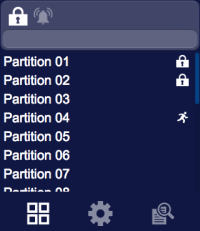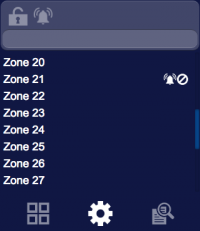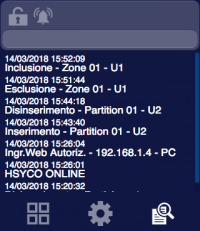Ksenia
The KSENIA lares 16IP/48IP/128IP are multi-area security systems. The integration with HSYCO can be accomplished via direct control through Ethernet connection. The I/O Server has been tested on units with product revision 1.6.1247, web server firmware version 1.0.0.15 and HTML version 1.1.33 and 1.1.44.
Contents
HSYCO Configuration
Add a KSENIA I/O Server in the I/O Servers section of the Settings and set its parameters:
Communication
- IP Address: host name or IP address of the panel
- IP Port: TCP/IP port assigned to the panel's web server
Authentication
- User: username to access the web server
- Password: password to access the web server
High Availability
- Shutdown when inactive: defaults to false.
Options
| ID | Default | Values | Description |
|---|---|---|---|
| startupevents | false | true | generate IO events also during the driver’s start-up phase |
| false | start generating events only after HSYCO is aligned with the current status of the system | ||
| pollinterval | 3 | n > 0 | the data acquisition interval, in seconds |
| logsize | 20 | n ≥ 0 | the number of log lines to display in the UI object |
| pin | <pin_code> | Default PIN code to be used for commands |
Datapoints
N.B. All the write (W) commands require a PIN code. If the I/O Server option "pin" is set, this code will be used to execute all commands that do not specify a PIN code. To specify a PIN code with a command append it to the value after a dot ('.').
EVENTS Example for I/O Server with ID "ks":
# arm partition 1 using pin 123456: ... : IO ks.p1.armed = 1.123456 # arm partition 1 using pin specified in pin option (the command will fail if pin not specified): ... : IO ks.p1.armed = 1
| ID | Value | R/W | Description |
|---|---|---|---|
| connection | online | R | connection established |
| offline | R | HSYCO can't connect to the panel | |
| model | <model_name> | R | product name of the panel |
| revision | <x.x.x> | R | product revision number |
| webserverfw | <x.x.x> | R | web server firmware version |
| webserverhtml | <x.x.x> | R | web server HTML version |
| p<n>.name | <name> | R | name of partition <n> |
| z<n>.name | <name> | R | name of zone <n> |
| o<n>.name | <name> | R | name of output <n> |
| scen<n>.name | <name> | R | name of scenario <n> |
| clock | read | W | request the reading of the panel's date and time |
| <date_and_time> | R | the panel's clock is set to <date_and_time>. The value's format is "yyyy-MM-dd HH:mm:ss" (e.g. 2018-08-30 16:30:00). This datapoint is only updated after a request with the command "clock = read" | |
| W | set the panel's clock to <date_and_time>. Use the format "yyyy-MM-dd HH:mm:ss" | ||
| bus.peripherals.ko | 0 | R | bus peripherals OK |
| 1 | R | error on bus peripherals | |
| panel.tamper | 0 | R | panel OK |
| 1 | R | panel tampered | |
| battery.low | 0 | R | battery OK |
| 1 | R | battery low | |
| battery.bad | 0 | R | battery OK |
| 1 | R | battery fault | |
| battery.volt | <v> | R | battery voltage |
| power.no | 0 | R | power supplies OK |
| 1 | R | at least one power supply not available | |
| power.ko | 0 | R | power supplies OK |
| 1 | R | at least one power supply faulty | |
| power.low | 0 | R | power supplies OK |
| 1 | R | at least one power supply with low voltage | |
| power.volt | <v> | R | main power supply voltage |
| gsm<n>.descr | <descr> | R | description of GSM peripheral <n> |
| gsm<n>.state | <state> | R | state of GSM peripheral <n>. See below for possible state values |
| gsm<n>.network.ko | 0 | R | network OK on GSM peripheral <n> |
| 1 | R | no GSM/GPRS network on GSM peripheral <n> | |
| pstn<n>.descr | <descr> | R | description of PSTN peripheral <n> |
| pstn<n>.state | <state> | R | state of PSTN peripheral <n>. See below for possible state values |
| pstn<n>.network.ko | 0 | R | network OK on PSTN peripheral <n> |
| 1 | R | no PSTN network on PSTN peripheral <n> | |
| ethernet.ko | 0 | R | ethernet connection OK |
| 1 | R | ethernet not connected | |
| bus.ko | 0 | R | Ks-bus OK |
| 1 | R | Ks-bus fault | |
| fuses.ko | 0 | R | fuses OK |
| 1 | R | fuses fault | |
| gemino<n>.descr | <descr> | R | description of gemino peripheral <n> |
| gemino<n>.state | <state> | R | state of gemino peripheral <n>. See below for possible state values |
| pontis<n>.descr | <descr> | R | description of pontis peripheral <n> |
| pontis<n>.state | <state> | R | state of pontis peripheral <n>. See below for possible state values |
| ergo<n>.descr | <descr> | R | description of ergo peripheral <n> |
| ergo<n>.state | <state> | R | state of ergo peripheral <n>. See below for possible state values |
| auxy<n>.descr | <descr> | R | description of auxy peripheral <n> |
| auxy<n>.state | <state> | R | state of auxy peripheral <n>. See below for possible state values |
| imago<n>.descr | <descr> | R | description of imago peripheral <n> |
| imago<n>.state | <state> | R | state of imago peripheral <n>. See below for possible state values |
| radius<n>.descr | <descr> | R | description of radius peripheral <n> |
| radius<n>.state | <state> | R | state of radius peripheral <n>. See below for possible state values |
| divide<n>.descr | <descr> | R | description of divide peripheral <n> |
| divide<n>.state | <state> | R | state of divide peripheral <n>. See below for possible state values |
| volo<n>.descr | <descr> | R | description of volo peripheral <n> |
| volo<n>.state | <state> | R | state of volo peripheral <n>. See below for possible state values |
| duo<n>.descr | <descr> | R | description of duo peripheral <n> |
| duo<n>.state | <state> | R | state of duo peripheral <n>. See below for possible state values |
| opis<n>.descr | <descr> | R | description of opis peripheral <n> |
| opis<n>.state | <state> | R | state of opis peripheral <n>. See below for possible state values |
| temp.in | <val> | R | measured indoor temperature |
| temp.out | <val> | R | measured outdoor temperature |
| gsm.signal | <val> | R | GSM signal strength |
| gsm.sim<n>.credit | <val> | R | available credit on GSM sim <n> |
| gsm.sim<n>.exp | <date_and_time> | R | expiration date of GSM sim <n> (format "yyyy-MM-dd HH:mm:ss") |
| armed | 0 | R | all partitions are disarmed |
| 1 | R | at least one partition is armed | |
| alarm | 0 | R | no partition is in alarm state |
| 1 | R | at least one partition is in alarm state | |
| p<n>.armed | 0 | R | partition <n> is disarmed |
| W | disarm partition <n> | ||
| 1 | R | partition <n> is armed | |
| W | arm partition <n> | ||
| imm | W | arm partition <n> immediately | |
| p<n>.alarm | 0 | R | partition <n> no alarm |
| 1 | R | partition <n> alarm | |
| p<n>.tamper | 0 | R | partition <n> no tamper alarm |
| 1 | R | partition <n> tamper alarm | |
| p<n>.exit | 0 | R | partition <n> no exit time active |
| 1 | R | partition <n> in exit time | |
| z<n>.bypass | 0 | R | zone <n> is not bypassed |
| W | unbypass zone <n> | ||
| 1 | R | zone <n> is bypassed | |
| W | bypass zone <n> | ||
| z<n>.open | 0 | R | zone <n> not open |
| 1 | R | zone <n> open | |
| z<n>.alarm | 0 | R | zone <n> no alarm |
| 1 | R | zone <n> alarm | |
| z<n>.alarm.mem | 0 | R | zone <n> no alarm memory |
| 1 | R | zone <n> alarm memory | |
| z<n>.tamper | 0 | R | zone <n> no tamper alarm |
| 1 | R | zone <n> tamper alarm | |
| z<n>.mask | 0 | R | zone <n> not masked |
| 1 | R | zone <n> masked | |
| o<n> | 0 | R | output <n> is off |
| W | turn off output <n> | ||
| 1 | R | output <n> is on | |
| W | turn on output <n> | ||
| scen<n> | 1 | W | set scenario <n> |
Peripherals state values
| Circuit status values | |
|---|---|
| Value | Description |
| no | no peripheral |
| no_com | no communication with peripheral |
| no_prog | peripheral not programmed |
| sab_no_com | tampered peripheral with no communication |
| sab_no_prog | tampered peripheral not programmed |
| sab | tampered peripheral |
| ok | peripheral OK |
User Interface
Ksenia Object
The user interface for the Ksenia multi-area intrusion detection system:
The Ksenia object is listed in the Project Editor’s new object list only when at least one Ksenia I/O Server is defined.
Parameters
- server id: the server ID. Supports Redirect variables
- position: the object's position. Use the pixels or rows and columns coordinates format
Syntax
(ksenia <server id>; <position>)
E.g.
(ksenia ks; x10y20)
UISET Actions
| ID | Attribute | Set to | |
|---|---|---|---|
| log | value | latest security log lines (as many as specified by the 'logsize' option) | |
| log0 | value | latest line of the security log when a new entry is added, set back to blank after a short period | |
| connection.online | visible | true | when datapoint connection = online |
| false | when datapoint connection = offline | ||
| connection.offline | visible | true | when datapoint connection = offline |
| false | when datapoint connection = online | ||
| <datapoint_id>.1 | visible | true | when datapoint with ID <datapoint_id> has value '1' |
| false | when datapoint with ID <datapoint_id> has value '0' | ||
| <datapoint_id>.0 | visible | true | when datapoint with ID <datapoint_id> has value '0' |
| false | when datapoint with ID <datapoint_id> has value '1' | ||
USER Commands
All writable datapoints can be set from USER commands by setting the ID field to the corresponding datapoint's ID and the Param field to the required value.
Log Files
If a Ksenia anti-intrusion unit is connected to HSYCO, the security.log file will be written in the same directories as the daily log files.
This file is never overwritten or deleted from HSYCO SERVER.
2018.02.20 16:59:28.516 - ks - 20/02/2018 16:56:36 - Disinserimento - Part 1 - U1 2018.02.20 17:00:24.527 - ks - 20/02/2018 16:57:36 - Inserimento - Part 1 - U1 2018.02.20 17:00:44.318 - ks - 20/02/2018 16:57:57 - Allarme - Zone 1 2018.02.20 17:00:49.241 - ks - 20/02/2018 16:57:58 - Ripristino - Zone 1 2018.02.20 17:00:54.043 - ks - 20/02/2018 16:58:06 - Disinserimento - Part 1 - U1 2018.02.20 17:01:18.905 - ks - 20/02/2018 16:58:29 - Fallita Comunicazione - Leonardo - Vocale GSM 2018.02.20 17:01:29.053 - ks - 20/02/2018 16:58:40 - Fallita Comunicazione - Leonardo - SMS
Other information about the Ksenia driver are stored in the message.log daily file.
Release Notes
3.8.0
- Bug fix: this I/O Server was considered as a regular I/O Server instead of a security system (SEC) when matching the license limits
3.7.0
- initial version release
Ksenia is a registered trademark of Ksenia Security s.r.l.


